Key Provisions of Fair Work Act 2009 and Other Acts
Added on 2023-01-11
27 Pages6906 Words26 Views
Managing People
Performance
Performance
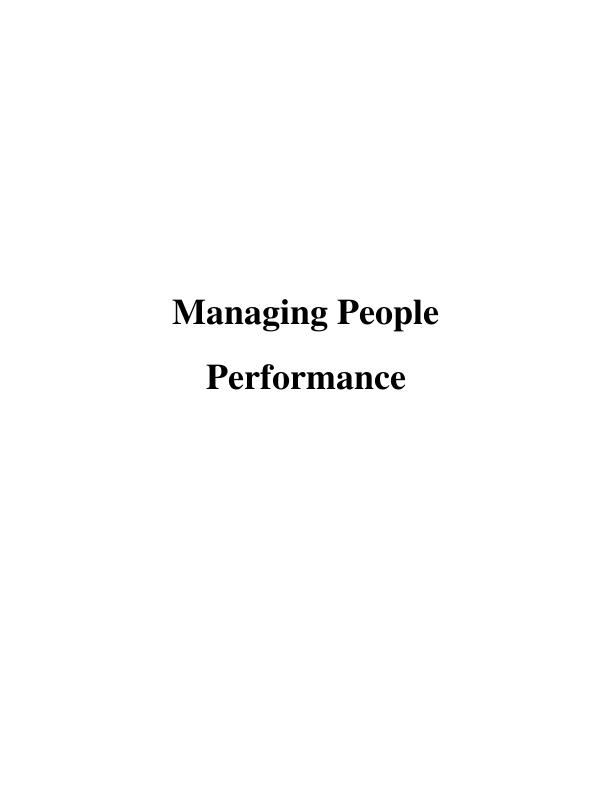

ASSESSMENT TASK 1
Q1. Explain the key provisions of the Fair Work Act 2009.
Fair Work Act 2009 is an Australian law which governs the entire workplaces and employment
organisations of Australia. This act was passed with an objective of establishing a framework which could help
in cultivation of productive workplace relationships to foster national and economic prosperity in the nation
(Forsyth and Stewart, 2009). The act lays down certain terms and conditions which define the responsibility of
employees, employer and employment organisations with respect to any employment contract. Some of the key
provisions included under the act for better employee protection are:
It gives the employees a right to request for flexible working arrangements.
It gives the employees protection against sudden termination and sets a minimum period of notice.
Provides other guidelines such as modern awards for ensuring safety net of terms and conditions
of employment.
Q2. Explain the key provisions of each of the following Acts.
The Racial Discrimination Act 1975
Provisions of The Racial Discrimination Act 1975 makes any kind of unfair treatment and discrimination on
the basis of background, race, colour. Ethnicity or origin against the law and aims to ensure that all the people
in Australia are being treated equally and have equal opportunities at the workplace (McCrudden, 1991).
Sex Discrimination Act 1984
The provision of Sex Discrimination Act 1984 makes any kind of discrimination at the workplace on the
basis of sex, marital status or pregnancy unlawful and against the law and it also makes any kind of sexual
harassment a legal offence (Magarey, 2004).
Disability Discrimination Act 1992
Disability Discrimination Act 1992 is a federal law which makes any kind of discrimination against people with
disabilities an act against law and a federal offence. Discrimination is also included in the failure of making
rationale arrangements and adjustments for people with disabilities (Tyler, 1993).
Q3. Explain the purpose of the National Employment Standards and the 10 minimum entitlements.
The National Employment Standards are ten minimum entitlements which must be provided by every
employer to all the employees in the organisation with an objective or purpose of protecting the workforce
against any possible exploitation (Hardy and Howe, 2009). These entitlements are as follows:
1. Maximum weekly hours – An employee can work up to a maximum of 38 hours per week plus
reasonable additional hours.
2. Right to request for flexible working arrangements – Some employees can ask to change their working
arrangement.
Q1. Explain the key provisions of the Fair Work Act 2009.
Fair Work Act 2009 is an Australian law which governs the entire workplaces and employment
organisations of Australia. This act was passed with an objective of establishing a framework which could help
in cultivation of productive workplace relationships to foster national and economic prosperity in the nation
(Forsyth and Stewart, 2009). The act lays down certain terms and conditions which define the responsibility of
employees, employer and employment organisations with respect to any employment contract. Some of the key
provisions included under the act for better employee protection are:
It gives the employees a right to request for flexible working arrangements.
It gives the employees protection against sudden termination and sets a minimum period of notice.
Provides other guidelines such as modern awards for ensuring safety net of terms and conditions
of employment.
Q2. Explain the key provisions of each of the following Acts.
The Racial Discrimination Act 1975
Provisions of The Racial Discrimination Act 1975 makes any kind of unfair treatment and discrimination on
the basis of background, race, colour. Ethnicity or origin against the law and aims to ensure that all the people
in Australia are being treated equally and have equal opportunities at the workplace (McCrudden, 1991).
Sex Discrimination Act 1984
The provision of Sex Discrimination Act 1984 makes any kind of discrimination at the workplace on the
basis of sex, marital status or pregnancy unlawful and against the law and it also makes any kind of sexual
harassment a legal offence (Magarey, 2004).
Disability Discrimination Act 1992
Disability Discrimination Act 1992 is a federal law which makes any kind of discrimination against people with
disabilities an act against law and a federal offence. Discrimination is also included in the failure of making
rationale arrangements and adjustments for people with disabilities (Tyler, 1993).
Q3. Explain the purpose of the National Employment Standards and the 10 minimum entitlements.
The National Employment Standards are ten minimum entitlements which must be provided by every
employer to all the employees in the organisation with an objective or purpose of protecting the workforce
against any possible exploitation (Hardy and Howe, 2009). These entitlements are as follows:
1. Maximum weekly hours – An employee can work up to a maximum of 38 hours per week plus
reasonable additional hours.
2. Right to request for flexible working arrangements – Some employees can ask to change their working
arrangement.
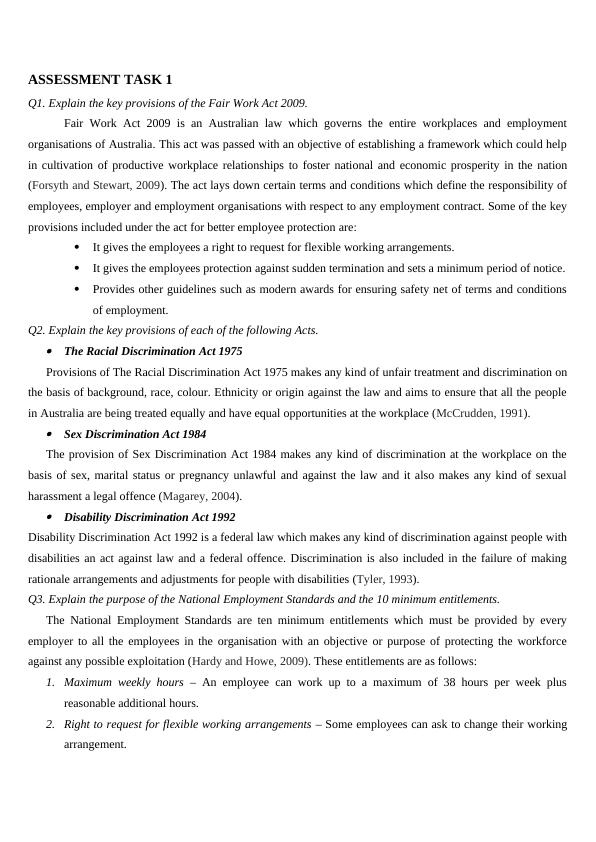
3. Parental leave and other related entitlements – Employees are entitled to receive up to 12 months of
unpaid leave and have a right to ask for another 12 months of unpaid leave, it also includes leaves
related to adoption.
4. Annual leave – Every employee is entitled to receive paid leaves for four weeks per year.
5. Personal leave – In a period of 12 month, every employee has the right to get 10 days of paid personal
leave, 2 days of unpaid career leave, 2 days of compassionate leave and 5 days of unpaid leave for
family and domestic violence.
6. Long service leave – These are the paid leaves granted to an employee who has been with an employer
for a long period of time.
7. Community service leave – Every employee is entitled to get unpaid leaves for voluntary emergency
service and a paid leave of up to 10 days for jury service.
8. Public Holidays – Every employee shall get a paid day off on a public holiday.
9. Notice period for termination and redundancy pay – A notice period of up to 5 weeks in case of
termination and up to 16 weeks in case of redundancy pay in necessary depending upon the type and
duration of the service period.
10. Fair work information statement – Every employee must be provided with a Fair Work Information
Statement by the employer.
Q4. Explain the use of modern awards in workplaces.
Modern Awards can be described as an integrated awards system which includes aspects and minimum
terms and conditions related to employment such as minimum wages, penalty rates, ordinary working hours,
allowance, types of employment, breaks, overtimes etcetera. At every workplace, modern awards generally
outlines all the terms and conditions of employment for both the employers and the employees which helps in
better employment regulation for organisations (Oliver, 2010).
Q5. Identify at least two examples of modern awards using the Fair Work Ombudsman website. Write down the
name of the award, the minimum annual or weekly wage for an adult employee and the ordinary hours of work
under the award.
Book Industry Award 2020:
The minimum weekly rate for full-time employment for an Editor on Level 1 is $1007.30 or $26.51 per
hour and the minimum weekly rate for a Publicist on Grade 1 is $972.10 or $25.58 per hour. The ordinary
working hours are maximum 38 hours per week or for an employee working 19 days in a 28-day cycle, 40
hours in each of the 3 weeks and 32 ordinary hours in any one week.
Clerks—Private Sector Award 2010:
unpaid leave and have a right to ask for another 12 months of unpaid leave, it also includes leaves
related to adoption.
4. Annual leave – Every employee is entitled to receive paid leaves for four weeks per year.
5. Personal leave – In a period of 12 month, every employee has the right to get 10 days of paid personal
leave, 2 days of unpaid career leave, 2 days of compassionate leave and 5 days of unpaid leave for
family and domestic violence.
6. Long service leave – These are the paid leaves granted to an employee who has been with an employer
for a long period of time.
7. Community service leave – Every employee is entitled to get unpaid leaves for voluntary emergency
service and a paid leave of up to 10 days for jury service.
8. Public Holidays – Every employee shall get a paid day off on a public holiday.
9. Notice period for termination and redundancy pay – A notice period of up to 5 weeks in case of
termination and up to 16 weeks in case of redundancy pay in necessary depending upon the type and
duration of the service period.
10. Fair work information statement – Every employee must be provided with a Fair Work Information
Statement by the employer.
Q4. Explain the use of modern awards in workplaces.
Modern Awards can be described as an integrated awards system which includes aspects and minimum
terms and conditions related to employment such as minimum wages, penalty rates, ordinary working hours,
allowance, types of employment, breaks, overtimes etcetera. At every workplace, modern awards generally
outlines all the terms and conditions of employment for both the employers and the employees which helps in
better employment regulation for organisations (Oliver, 2010).
Q5. Identify at least two examples of modern awards using the Fair Work Ombudsman website. Write down the
name of the award, the minimum annual or weekly wage for an adult employee and the ordinary hours of work
under the award.
Book Industry Award 2020:
The minimum weekly rate for full-time employment for an Editor on Level 1 is $1007.30 or $26.51 per
hour and the minimum weekly rate for a Publicist on Grade 1 is $972.10 or $25.58 per hour. The ordinary
working hours are maximum 38 hours per week or for an employee working 19 days in a 28-day cycle, 40
hours in each of the 3 weeks and 32 ordinary hours in any one week.
Clerks—Private Sector Award 2010:
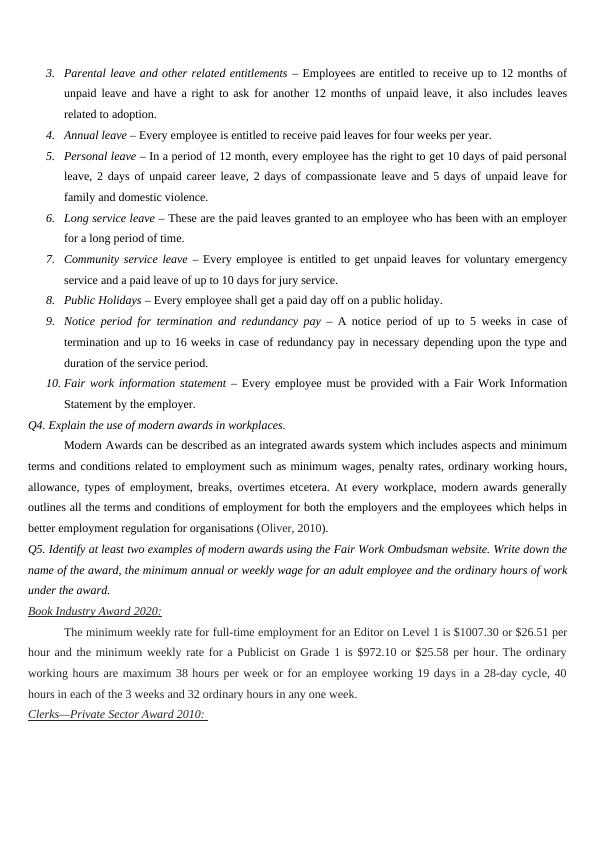
The minimum weekly wages for Level 1 employee is $787.60 per week, Level 2 employee is $862.50 per
week and for Level 3 employee is $911.00 per week. The ordinary working hours described under this award
are maximum 38 hours per week for full-time employment.
Q6. Outline the purpose of an enterprise agreement. With which entity must an agreement be registered?
Enterprise agreement is an agreement between employer and employee of an organisation which
determines the minimum terms and conditions of employment and identifies the employees for whom the
agreement applies (Jones, 1995). An enterprise agreement must be approved by and registered with Fair Work
Ombudsman (FWO).
Q7. Outline minimum terms and conditions that must be included in an enterprise agreement.
An enterprise agreement must cover the following terms and conditions:
1. Agreed rate of pay which should not be less than the minimum weekly or hourly rates identified under
modern awards.
2. A normal expiry period for the agreement which should not be more than 4 years.
3. Conditions of employment such as working hours not more than maximum limit prescribed, overtime
rules etcetera.
4. Provision of deduction from wages for any reason or purpose which has to be authorised by the
employee.
5. Procedure for resolution of disputes between the employer and the employees.
Q8. Explain the process of performance management and the purpose of using performance management
systems in the workplace.
Performance management can be defined as a process which is used by an organisation to ensure that all
the employees in the organisation are aware about the performance or productivity level expected from them
with the help of setting standards of performance (Aguinis, 2009). Performance management systems help an
organisation in achieveing maximum productivity and efficiency levels from its employees and ensuring that
every employee is performing to the best level of his potential and meeting the expectations.
Q9. Explain two types of performance management systems that can be used at work.
1. Technological performance appraisal: This method of performance management system focuses on
assessment of the technical ability and quality of the employee more than any other job aspect (Murphy
and Cleveland, 1995). It is useful where employees usually require any specialised technical skill for
execution of the task and job roles.
2. Project Evaluation review: It involves a review and an appraisal system of the entire team members
after the completion of every project with an objective of improving and developing the team along with
each passing project instead of a review at the end of the year. This type of performance management
week and for Level 3 employee is $911.00 per week. The ordinary working hours described under this award
are maximum 38 hours per week for full-time employment.
Q6. Outline the purpose of an enterprise agreement. With which entity must an agreement be registered?
Enterprise agreement is an agreement between employer and employee of an organisation which
determines the minimum terms and conditions of employment and identifies the employees for whom the
agreement applies (Jones, 1995). An enterprise agreement must be approved by and registered with Fair Work
Ombudsman (FWO).
Q7. Outline minimum terms and conditions that must be included in an enterprise agreement.
An enterprise agreement must cover the following terms and conditions:
1. Agreed rate of pay which should not be less than the minimum weekly or hourly rates identified under
modern awards.
2. A normal expiry period for the agreement which should not be more than 4 years.
3. Conditions of employment such as working hours not more than maximum limit prescribed, overtime
rules etcetera.
4. Provision of deduction from wages for any reason or purpose which has to be authorised by the
employee.
5. Procedure for resolution of disputes between the employer and the employees.
Q8. Explain the process of performance management and the purpose of using performance management
systems in the workplace.
Performance management can be defined as a process which is used by an organisation to ensure that all
the employees in the organisation are aware about the performance or productivity level expected from them
with the help of setting standards of performance (Aguinis, 2009). Performance management systems help an
organisation in achieveing maximum productivity and efficiency levels from its employees and ensuring that
every employee is performing to the best level of his potential and meeting the expectations.
Q9. Explain two types of performance management systems that can be used at work.
1. Technological performance appraisal: This method of performance management system focuses on
assessment of the technical ability and quality of the employee more than any other job aspect (Murphy
and Cleveland, 1995). It is useful where employees usually require any specialised technical skill for
execution of the task and job roles.
2. Project Evaluation review: It involves a review and an appraisal system of the entire team members
after the completion of every project with an objective of improving and developing the team along with
each passing project instead of a review at the end of the year. This type of performance management
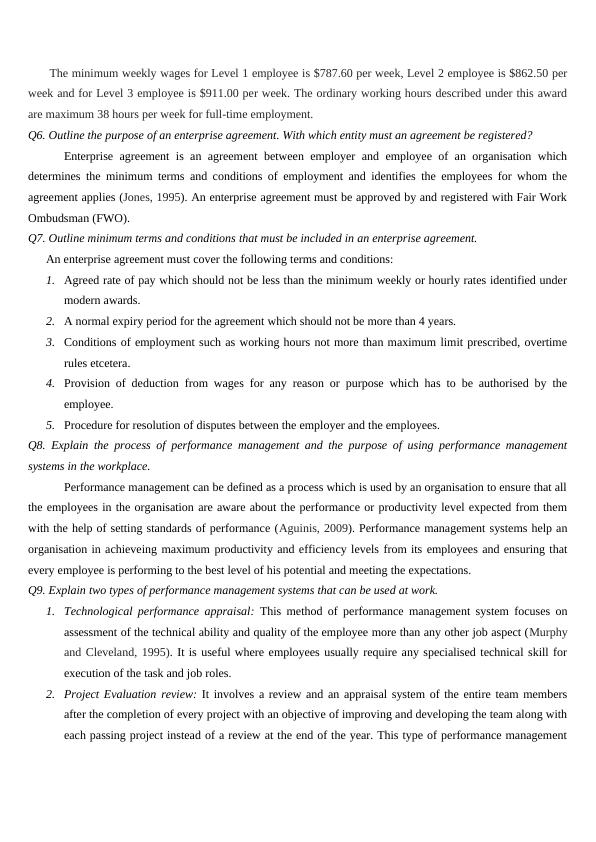
system is highly effective for organisations where teams are formed on the basis of project requirements
and specifications.
Q10. Under the Fair Work Act, what amount of notice must an employer give to an employee who has worked
for the company for less than a year when terminating their employment?
As per the provision of Fair Work Act, a one week notice must be given by an employer for termination of
an employee who has worked for less than a year in the organisation.
Q11. List two types of employees to whom a notice of termination would not need to be provided.
An employer is under no compulsion to provide a notice of termination for the following employees:
379574
Employees working as daily hire workers in the construction industry
An employee who was hired for any specific period of time, or for a specified task or for a duration of a
specified season.
Q12. Under what circumstances is an employee entitled to redundancy pay?
An employee is entitled to receive redundancy payment from the employer in the circumstances where
the employee’ role or job becomes redundant or is no longer required by the company or the employer (Booth
and McCulloch, 1999). The terms of redundancy pay are determined on the basis of length of the service.
However, redundancy pay in not applicable in cases where the job becomes redundant due to employee’s
performance or misconduct.
Q13. Explain at least three circumstances that may constitute unfair dismissal.
Unfair dismissal can be described as a situation where an employee is terminated or dismissed from his job
on grounds which are not reasonable and just (Ewing and Hendy Qc, 2012). Circumstances where a dismissal
may be regarded as an unfair dismissal are as follows:
Where an employee is terminated on the basis of any grounds of discrimination such as employee’s race,
sex, colour, sexual orientation, political opinion, marital status, nationality, origin etcetera.
Where an employee is dismissed or terminated on the basis of poor performance by the employee
without a reasonable chance or opportunity being provided to the employee to improve his performance.
Where an employee is terminated by the employer without following the proper process of termination
of an employee.
Where an employee is terminated or dismissed by the employer because a right has been exercised or an
intention to exercise any right has been shown by the employee such as making a complaint.
Q14. Which circumstances must apply for the Fair Work Commission to determine that an employee has been
unfairly dismissed?
and specifications.
Q10. Under the Fair Work Act, what amount of notice must an employer give to an employee who has worked
for the company for less than a year when terminating their employment?
As per the provision of Fair Work Act, a one week notice must be given by an employer for termination of
an employee who has worked for less than a year in the organisation.
Q11. List two types of employees to whom a notice of termination would not need to be provided.
An employer is under no compulsion to provide a notice of termination for the following employees:
379574
Employees working as daily hire workers in the construction industry
An employee who was hired for any specific period of time, or for a specified task or for a duration of a
specified season.
Q12. Under what circumstances is an employee entitled to redundancy pay?
An employee is entitled to receive redundancy payment from the employer in the circumstances where
the employee’ role or job becomes redundant or is no longer required by the company or the employer (Booth
and McCulloch, 1999). The terms of redundancy pay are determined on the basis of length of the service.
However, redundancy pay in not applicable in cases where the job becomes redundant due to employee’s
performance or misconduct.
Q13. Explain at least three circumstances that may constitute unfair dismissal.
Unfair dismissal can be described as a situation where an employee is terminated or dismissed from his job
on grounds which are not reasonable and just (Ewing and Hendy Qc, 2012). Circumstances where a dismissal
may be regarded as an unfair dismissal are as follows:
Where an employee is terminated on the basis of any grounds of discrimination such as employee’s race,
sex, colour, sexual orientation, political opinion, marital status, nationality, origin etcetera.
Where an employee is dismissed or terminated on the basis of poor performance by the employee
without a reasonable chance or opportunity being provided to the employee to improve his performance.
Where an employee is terminated by the employer without following the proper process of termination
of an employee.
Where an employee is terminated or dismissed by the employer because a right has been exercised or an
intention to exercise any right has been shown by the employee such as making a complaint.
Q14. Which circumstances must apply for the Fair Work Commission to determine that an employee has been
unfairly dismissed?
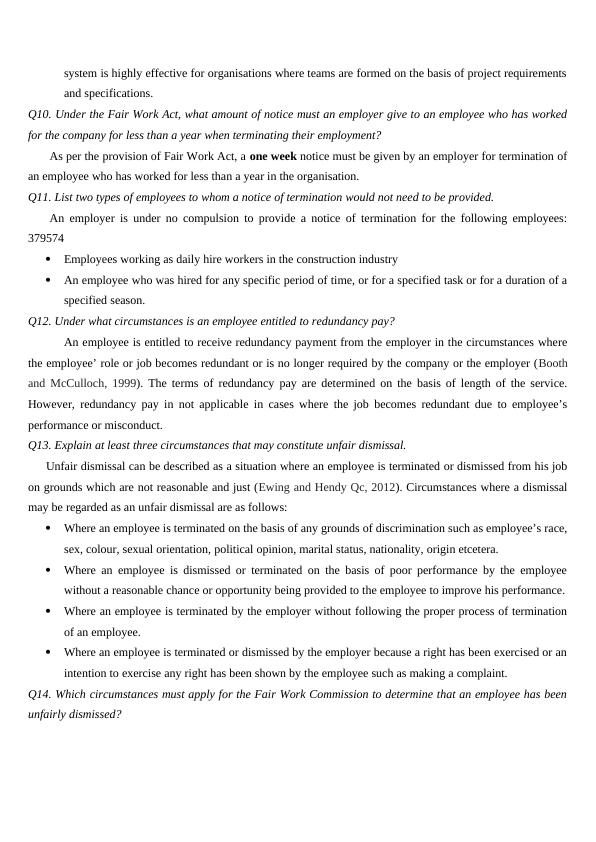
End of preview
Want to access all the pages? Upload your documents or become a member.
Related Documents
WHS Human Resource Management Answer 2022lg...
|38
|5945
|29
Manage People Performancelg...
|29
|8431
|332
BSBGMT616 Health and safetylg...
|31
|6224
|27
BSBHRM501 Manage Human Resource Services Assignmentlg...
|8
|1552
|117
BSBSUS301 Implement and Monitor Environmentally Sustainable Work Practiceslg...
|12
|3176
|70
National Employment Standards (NES) in Australia - Deskliblg...
|6
|1150
|155